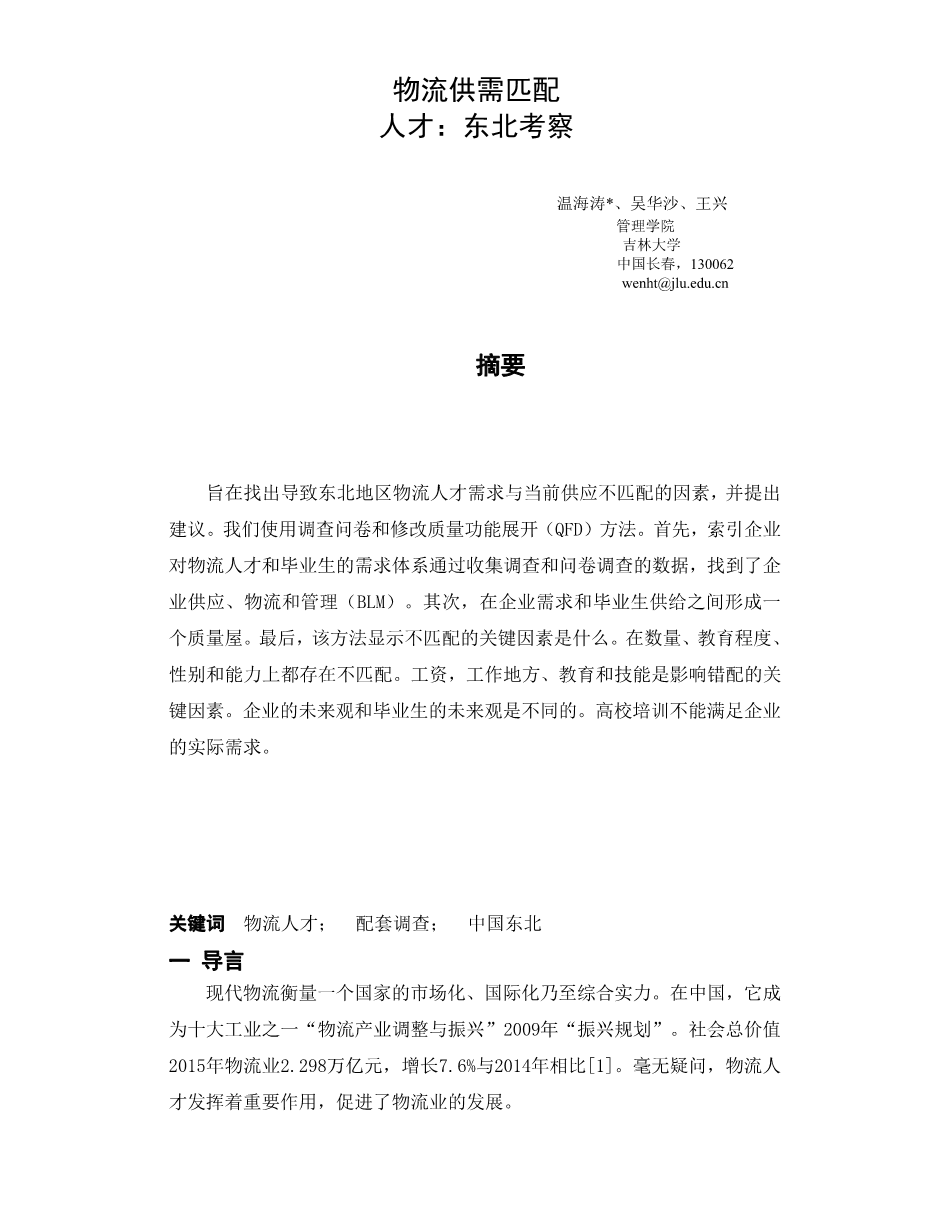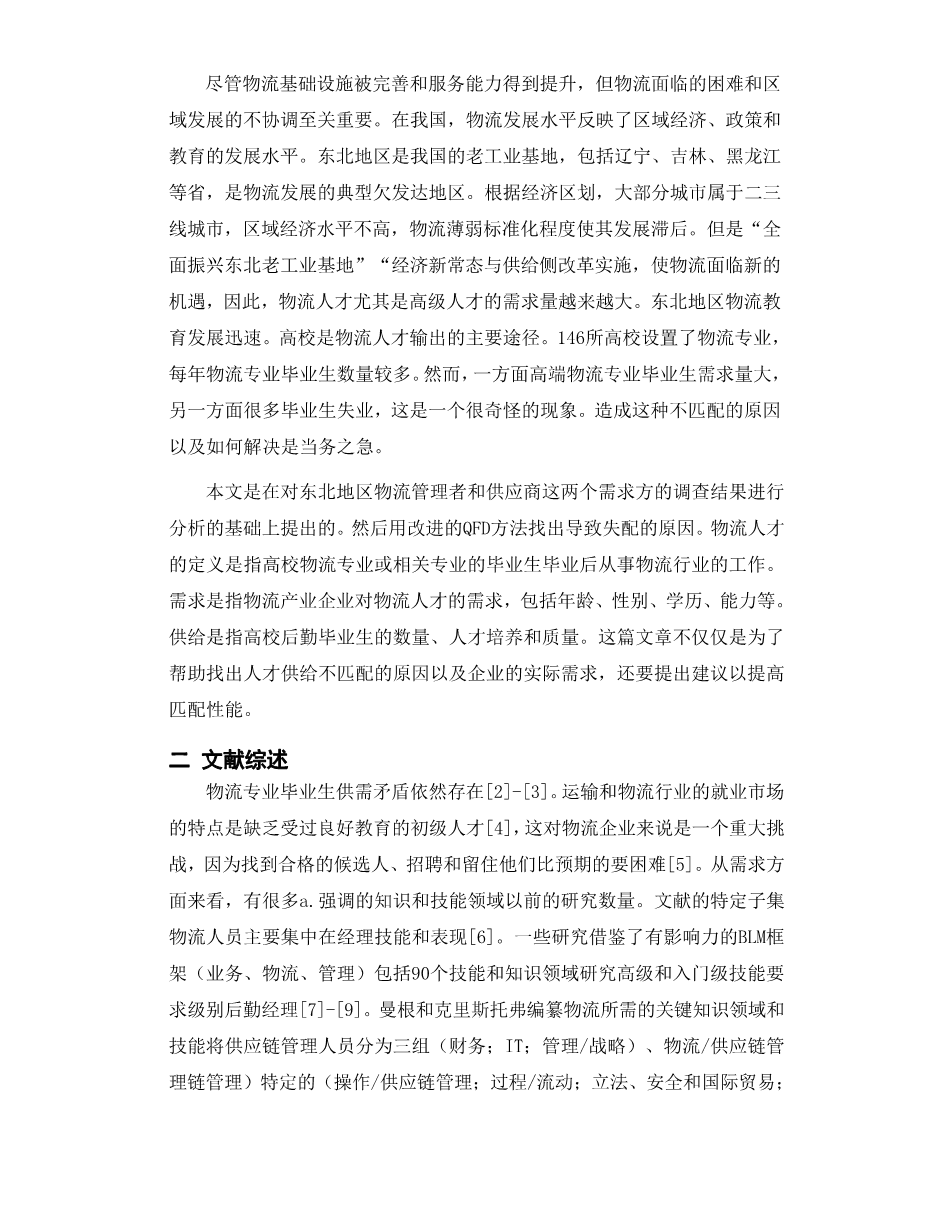Matching the Supply of and Demand for Logistics
Talent: an Investigation in Northeast of China
Haitao Wen*, Huasha Wu, Xing Wang
School of Management
Jilin University
Changchun, 130062, China
wenht@jlu.edu.cn
Abstract—The paper aims to find out the factors leading to mismatch between the demand of and current supply of the logistics talents in northeast China and propose suggestions to the
problem. We use investigation, questionnaire and modified
Quality Function Deployment (QFD) methods. Firstly, an index
system of enterprises demands for logistics talents and graduates
supply by using Business, Logistics and Management (BLM) is found by collecting data from investigation and questionnaires. Secondly, a house of quality is formed between the enterprise demand and graduates supply. Eventually, the method shows
what key factors of the mismatches are. Mismatches are showed in quantity, education, gender and abilities. Salary, working
place, education and skills are the key factors affect mismatch. The enterprisesrsquo; prospective and graduatesrsquo; perspective are different. Universities and collegesrsquo; training couldnrsquo;t meet the enterprises actual demands.
Keywords—logistics talent; matching investigation; northeast China
- INTRODUCTION
Modern logistics measures a countryrsquo;s power on marketing, internalization and even the comprehensive strength. In China, it became one of top ten industrial
revitalization by “Logistics industry adjustment and
revitalization planning” in 2009. The total value of social
logistics in 2015 is 229.8 trillion Yuan, increasing 7.6%
compared with 2014 [1]. And there is no doubt that logistics
talents play a significant role and make a great contribution to
logistics industry.
Although optimistic logistics infrastructure perfection and service capacity improvement, logistics confronted difficulties and regional development disharmony is crucial. In China, logistics development level reflects regional economy, policy and education development. The northeast region was Chinarsquo;s old industrial base, which includes Liaoning, Jilin and Heilongjiang provinces, representative underdeveloped region of logistics development. According to the economic division, most cities belong to the secondary-tier and third-tier cities, inadequate regional economic level and weak logistics
standardization degree make it underdeveloped. But
“Comprehensive revitalization of northeast old industrial base
”, economic new normality and the supply side reform are in
implementation, which make logistics face new opportunities,
so quantity of logistics talents especially senior talents are in demand. Logistics education is developing fast in northeast region. Universities and colleges are main approaches to logistics talent output. 146 universities and colleges set logistics majors and logistics graduates quantity is large each year. However, there is a strange phenomenon that on the one hand high-end logistics graduates in a high demand while on the other hand many graduates are unemployed. What caused the mismatch and how to solve it is urgent.
The paper is based on the analysis of the responses of investigation of the demand side--logistics managers and the supplier --logistics talents in northeast regions. Then using modified QFD method find what makes mismatch. The definition of logistics talents refer to the graduates in logistics or related majors from universities and colleges who would work in logistics industry after graduating. Demand means logistics talent demands of logistics industrial enterprises, including age, gender, educational background, ability and so on. Supply means colleges and universities logistics graduates quantity, talent training and quality. The paper is not only to
help find the reasons of mismatch between talents supply and
the enterprise actual demand, but also to propose suggestions
to improve matching performance.
- LITERATURE REVIEW
The mismatch between the supply and demand for logistics graduates persists [2]-[3]. Job markets in the transport and logistics industry are characterized by a scarcity of well- educated junior talents [4].This has been a major challenge for logistics enterprises, as finding qualified candidates, recruiting them, and retaining them have proven to be harder than expected [5]. From demand aspect, there are a number of
knowledge and skills areas that have been emphasized by a
number of previous studies. The specific subset of literature
on logistics personnel has predominantly focused on manager
skills and performance [6]. Several studies draw on the
influential BLM-framework (business, logistics, management)
by Poist, which includes 90 skills and knowledge areas, in
order to study the skill requirements of both senior and entry
level logistics managers [7]-[9]. Mangan and Christopher
codify key knowledge areas and skills required by logistics
and supply chain managers into three groups – general
(finance; IT; management/strategy), logistics/SCM (supply
chain management) specific (operations/SCM; processes
This work had been supported by Social Sciences Research Foundation during the 13th Five-Year Period of Education Bureau of Jilin Province, China (Grant No. 452)
/flows; legislation, security and international trade;
multimodal logistics; logistics in emerging markets) and
competencies/skills [10]. At the same time, Sezi observes and
finds that soft skills are explained as communication, writing,
剩余内容已隐藏,支付完成后下载完整资料


英语译文共 8 页,剩余内容已隐藏,支付完成后下载完整资料
资料编号:[607301],资料为PDF文档或Word文档,PDF文档可免费转换为Word


